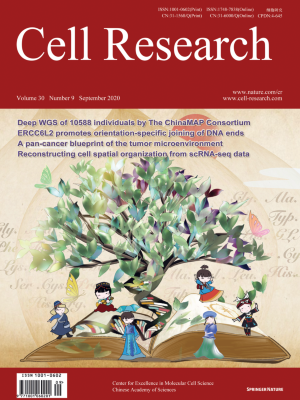
Advanced Search
Submit Manuscript
Advanced Search
Submit Manuscript
Volume 30, No 9, Sep 2020
ISSN: 1001-0602
EISSN: 1748-7838 2018
impact factor 17.848*
(Clarivate Analytics, 2019)
Volume 30 Issue 9, September 2020: 732-744
ERCC6L2 promotes DNA orientation-specific recombination in mammalian cells
Xiaojing Liu1,2,† , Tingting Liu1,2,† , Yafang Shang1,2,† , Pengfei Dai1,2,† , Wubing Zhang3 , Brian J. Lee4 , Min Huang1,2 , Dingpeng Yang1,2 , Qiu Wu3 , Liu Daisy Liu1,2 , Xiaoqi Zheng5 , Bo O. Zhou1,2 , Junchao Dong6 , Leng-Siew Yeap7 , Jiazhi Hu8 , Tengfei Xiao9 , Shan Zha4 , Rafael Casellas10 , X. Shirley Liu11 , Fei-Long Meng1,2,*
1State Key Laboratory of Molecular Biology, Shanghai Institute of Biochemistry and Cell Biology, Center for Excellence in Molecular Cell Science, Chinese Academy of Sciences, Shanghai 200031, China;Programmed DNA recombination in mammalian cells occurs predominantly in a directional manner. While random DNA breaks are typically repaired both by deletion and by inversion at approximately equal proportions, V(D)J and class switch recombination (CSR) of immunoglobulin heavy chain gene overwhelmingly delete intervening sequences to yield productive rearrangement. What factors channel chromatin breaks to deletional CSR in lymphocytes is unknown. Integrating CRISPR knockout and chemical perturbation screening we here identify the Snf2-family helicase-like ERCC6L2 as one such factor. We show that ERCC6L2 promotes double-strand break end-joining and facilitates optimal CSR in mice. At the cellular levels, ERCC6L2 rapidly engages in DNA repair through its C-terminal domains. Mechanistically, ERCC6L2 interacts with other end-joining factors and plays a functionally redundant role with the XLF end-joining factor in V(D)J recombination. Strikingly, ERCC6L2 controls orientation-specific joining of broken ends during CSR, which relies on its helicase activity. Thus, ERCC6L2 facilitates programmed recombination through directional repair of distant breaks.
https://doi.org/10.1038/s41422-020-0328-3